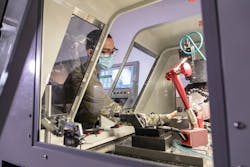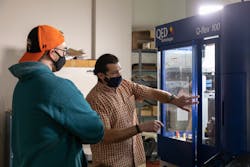Prior to the last Thursday’s annual meeting of the NY Photonics Association in Rochester, NY, Jeff Ruckman, CEO & President of the American Center for Optics Manufacturing (AmeriCOM) met with Laser Focus World via video call where he outlined plans to bolster the domestic precision optics industry.
In June, the center announced that it had been selected for a five-year, $34 million grant from the Department of Defense (DOD) Office of Industrial Policy program, to launch a nationwide public-private workforce training initiative and a defense precision optics consortium—also known as the Defense Precision Optics Workforce Development and Technology Ecosystem Project.
The partnership between the U.S. government, industry, and academia will boost the domestic precision optics industry by identifying gaps in the precision optics defense industrial base and undertaking new R&D to solve the industry’s technical challenges, thereby securing the supply chain. The project will couple precision optics workforce and technology development initiatives to enable the workforce to keep pace with technology advancements.
Ruckman said that high precision optics are pervasive in the military—from night vision goggles and directed energy systems that must meet extreme optical performance requirements, to complex windows, domes, and corrector optics for hypersonic missiles.
“The capacity of the nation's optics industrial manufacturing base is a national security concern,” Ruckman explained, “and AmeriCOM is uniquely positioned, and specifically designated by the DOD, to assess and address critical gaps in defense systems, the optics supply chain, and future industry needs.”
Detailed assessment of the precision optics manufacturing base determined that an eight-fold increase in the number of precision optics technicians would be needed in the next five years, according to Ruckman.
“If you don’t have the technology or workforce to manufacture a new class of optics, then you can’t design them into equipment,” he explains. “As scarce as optical engineers are today, for each optical engineer, estimates indicate that the industry needs approximately six technicians to create the optics and make the components that will work in real world applications.”
The Rochester training model, Ruckman said, with leadership from Alexis Vogt, Endowed Chair and Professor of Optics at Monroe Community College, will serve as a guide for many opportunities that AmeriCOM hopes to create in its quest to scale up optics programs across the United States.
With the goal of producing optics technicians at a rate fast enough to meet workforce demand, Vogt will serve as AmeriCOM’s director of workforce training. Josanne DeNatale, AmeriCOM’s national marketing director, will focus on high school outreach to nontraditional learners offering dual- and nondegree and certificate programs to drive students into the program pipeline around the country.
While AmeriCOM will duplicate activities of the Rochester optics and photonics cluster as a model for many of its workforce training activities, it’s prepared to tailor the programs to meet the specific needs of optics and photonics communities around the country, including those in New Jersey, Montana, Florida, and Arizona — each of which features its own optics and photonics cluster.
With the funding it has already received for two of its five years, AmeriCOM will first address education, particularly at the high school and two-year college level. To meet nationwide demand for skilled optics technicians, AmeriCOM will focus on technician-level workforce training by identifying high-school students seeking well paid, hands-on careers and offering them dual-credit courses to feed optics programs at local community colleges.
In August, Sussex County Community College (SCCC; Newton, NJ) became the first college to partner with AmeriCOM under the DOD-funded project. Ruckman notes that success will depend on regional industry clusters that are heavily supportive of the community colleges. For example, Thorlabs (Newton, NJ), Inrad Optics (Northvale, NJ), Esco Optics (Oak Ridge, NJ), and Special Optics (Denville, NJ) are excited to support and partner with SCCC as they launch their program in the spring semester of 2022. A second program is expected to launch in the fall semester of 2022 at Front Range Community College (Boulder, CO). AmeriCOM expects to develop additional degree and certificate programs in the next five years and has identified additional two-year colleges with which it expects to partner in the near term.
Ruckman also laid out AmeriCOM’s first wave of technical development activities, which includes creating DOD and industry advisory and review boards to oversee the execution of its research agenda. AmeriCOM initiatives will address manufacturing and design challenges in directed energy and hypersonic optics, such as the need to design military systems at greater scale.
“We need to get the message out to industry stakeholders to get involved. We are well funded and ready to help. There is no cost to join AmeriCOM. We want input to help set the agenda for workforce training and to develop uniquely competitive technologies for the US optics industry,” Ruckman said.
Additionally, a session entitled “AmeriCOM: A new optics manufacturing and workforce training consortium,” will be available to attendees at SPIE's Optifab conference and exhibition running Oct. 19-21 in Rochester.

John Lewis | Editor in Chief (2018-2021)
John Lewis served as Editor in Chief of Laser Focus World from August 2018 through October 2021, after having served as the Editor in Chief of Vision Systems Design from 2016 to 2018. He has technical, industry, and journalistic qualifications, with more than 13 years of progressive content development experience working at Cognex Corporation. Prior to Cognex where his articles on machine vision were published in dozens of trade journals, he was a technical editor for Design News, covering automation, machine vision, and other engineering topics, for over six years.


